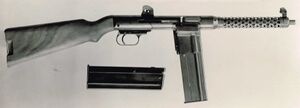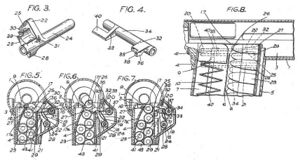PA-62: Difference between revisions
(Created page with "{{wip}} {{infobox weapon | name = PA-62 | image = 300px | caption = A Pequeñoyan Service PA-62 | origin =...") |
No edit summary |
||
| Line 1: | Line 1: | ||
{{infobox weapon | {{infobox weapon | ||
| name = PA-62 | | name = PA-62 | ||
Revision as of 06:14, 12 June 2019
| PA-62 | |
|---|---|
 A Pequeñoyan Service PA-62 | |
| Type | Submachine gun |
| Place of origin | |
| Service history | |
| In service | 1962 - 1998 |
| Used by | |
| Production history | |
| Designed | 1958 - 1962 |
| Manufacturer | Pequeñoya Armería |
| Produced | 1962 - 1975 |
| Specifications | |
| Weight | 4.18 kg (9.22 lb) loaded |
| Length | Overall: 812 mm (32 in) |
| Barrel length | 250 mm (10 in) |
| Cartridge | 9x23mm Largo |
| Action | Blowback, Closed Bolt |
| Rate of fire | 900-1000 RPM |
| Muzzle velocity | 400 m/s (1,310 ft/s) |
| Effective firing range | 300m |
| Feed system | 60 round box magazines |
| Sights | Iron |
The PA-62 (Pistola Automática Model of 1962) is a Pequeñoyan 9×23mm Largo select fire submachine gun manufactured by Pequeñoya Armería. It is notable for its size, being as large and heavy as some rifle carbines, and for its unique double-stack, twin-column magazines.
Development
After the Pequeñoyan War of Independence in 1958, the need for more automatic weapons was apparent. The standard rifle of the Pequeñoyan Territorial Defense Force at the time of the war was the Aisling semi-automatic IR-49. While effective at shooting at moderate distances, these rifles were significantly outperformed in the heavily urbanized areas of Pequeñoya by submachine guns and automatic rifles. In particular, Aisling Cazadores armed with the IRA-57 were capable of far exceeding the volume of fire of an equivalently sized Pequeñoyan rifle squad equipped with the IR-49.
Shortly after the conclusion of the war, the newly formed Pequeñoyan Army issued a requirement for an automatic submachine gun or carbine rifle that was more suited for the close-range engagements that were prevalent in the war. While there were several proposals made, only two made it past the conceptual stage. The first being a short-barrel, automatic conversion of the IR-49, with the second being what would become the PA-61. During trials, the PA-61's competitor showed a lack of controlability in automatic fire and a limited magazine size prevented the weapon from making full use of its automatic fire capability. As it was primarily envisioned as a defensive weapon to be used in the case of an invasion of Pequeñoya, the 9x23mm round's lackluster performance at long range was not considered to be a significant factor. For these reasons, the relatively less conventional PA-61 prototype was determined to be the victor of these trials and ordered into production.
Design Details
The PA-62 is a relatively simple submachinegun that operates on a simple blowback action with a closed bolt. The factory-standard iron sights could be adjusted between 100, 200, or 300 meter positions. It possessed a configurable bolt that allowed the operator of the weapon to adjust its rate of fire between 900 and 1000 rounds per minute. A simple fire selector was present that allowed switching between fully and semi-automatic fire modes. Unlike most of its contemporaries, the PA-61 did not feature a pistol grip.
A unique feature of the PA-62 was its magazine. The magazine was a magazine that contained two separated, double stack columns of ammunition. The forward column contained 31 rounds, while the rear contained 29, giving a total of 60 rounds per magazine. This makes the magazines relatively wide and heavy but maintains a manageable length. In order to ensure proper feeding, an interlock lever is built into the magazine that keeps the rear column below the travel path of the bolt until the front column is empty. Once the front column is empty, the lever disengages, allowing the rear column of ammunition to rise into the magazine's feed lip.
Due to its size, the weapon was also issued with a 20 cm (8 in) spike bayonet. When not needed, the bayonet could be mounted in reverse above the barrel shroud. This bayonet was not frequently used, as it was a meme. The fixed buttstock is attached via a set of locking tabs, which can be quickly disengaged to allow removal of the stock for more compact storage.
A modification of the PA-62 designed for Pequeñoyan special forces, designated PA-62P, was also developed in 1968. This variant had an interrupted thread to allow the barrel and shroud assembly to be easily detached and reattached from the receiver, and were also commonly issued with shortened, threaded barrels to accept a suppressor. These modifications were to allow the PA-62 to better function as a weapon for airborne and/or covert operations. An estimated 800 PA-62Ps were manufactured in total.
Operational History
Variants
- PA-62
- PA-62P

